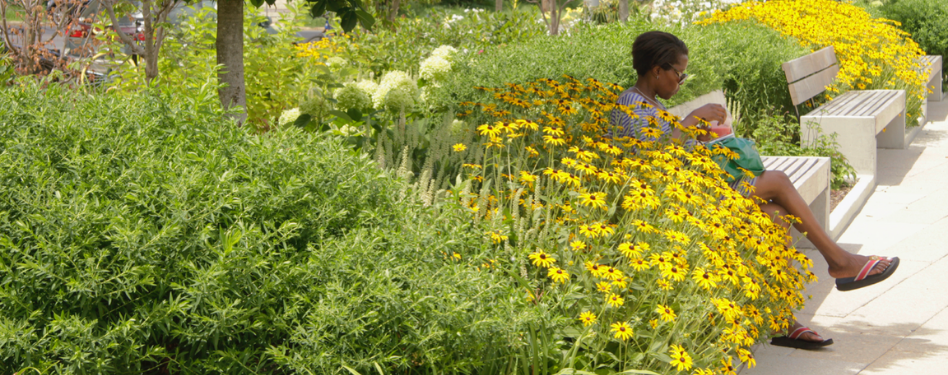
In the early 2000s, several well-established interest groups with overlapping agendas were engaged in parallel discussions. The U.S. Green Building Council’s Leadership in Energy and Environmental Design (LEED) rating system was measurably changing the building industry for the better. Environmental and landscape-oriented organizations were impressed but felt something was missing. LEED was wonderfully sophisticated about inside-the-building systems metrics, but less so outside the building envelope. For building sites, early LEED suggested the use of native plants and the conservation of water—both worthy objectives, but not as thoroughly developed as the building standards.
I was active in both the American Society of Landscape Architects (ASLA) and the Lady Bird Johnson Wildflower Center (LBJWC), two groups engaged in these discussions. I suggested that we convene a gathering to explore the creation of a LEED-like rating system for the outdoors. The two organizations came together in Austin, Texas, in 2004, attracting several allied organizations, including the U.S. General Services Administration (GSA), the U.S. Environmental Protection Agency, and USGBC. The participants at the gathering committed to develop a new site-scale rating system in cooperation with USGBC, which would hopefully be integrated into LEED and could also function to assess sustainability for places without buildings.
The Sustainable SITES Initiative was launched soon afterward, with the U.S. Botanic Garden joining the LBJWC and ASLA in leading the effort. We soon gathered a committed team of environmental scientists, botanists, landscape architects, engineers and others to contribute their knowledge and expertise. I played several roles. The first was administrative and grew after 2006 when the LBJWC became part of the University of Texas at Austin, where I was the dean of the School 0f Architecture. I also contributed to the substance of the rating system. As a protégé of Ian McHarg, I have a background in ecology, hydrology, and soil science. I wrote my dissertation on soil conservation policy, so I took an especially keen interest in the soils aspects of the Sustainable SITES Initiative.
Very early on, we decided to use the ecosystem services concept to guide the Sustainable SITES Initiative, thus grounding the system design in science. The first iteration of the new rating system was published in 2009 and we issued a call for pilot projects to test the system. Over 175 projects from across the United States and from Canada, Spain, and Iceland responded. Of these projects, 47 would meet the standards for certification. This early version of what became SITES was also adopted into the New York City Department of Parks & Recreation for its new landscape performance guidelines in 2010 and elements were also incorporated into newer versions of LEED.
The pilot projects were essential for the development of the second iteration of SITES, called SITES v2. In 2015, the LBJWC and ASLA transferred the ownership of SITES to Green Business Certification Inc., which oversees the certification of LEED and other rating sustainability-centric systems. Since then, SITES has been adopted by government agencies in the United States at the federal (GSA), state (Arizona and Rhode Island), and local (Atlanta and Chicago) levels. While the use of SITES by private and non-profit groups is certainly important, the adoption of SITES by public entities at all levels of government is noteworthy as an indicator of the system’s utility and promise.
I spoke more about the importance of landscape governance recently in the journal Socio-Ecological Practice Research. Read the full article here.
Frederick Steiner (MRP’77, MA’86, PhD’86) is Dean of the University of Pennsylvania Stuart Weitzman School of Design. Most recently, he served as Dean of the School of Architecture and Henry M. Rockwell Chair in Architecture at The University of Texas at Austin for 15 years. He previously taught at Penn and the following institutions: Arizona State University, Washington State University, the University of Colorado at Denver. He was a visiting professor of landscape architecture at Tsinghua University in Beijing, China. Dean Steiner was a Fulbright-Hays scholar at Wageningen University, The Netherlands and a Rome Prize Fellow in Historic Preservation at the American Academy in Rome. During 2013-2014, he was the William A. Bernoudy Architect in Residence at the American Academy in Rome. He is a Fellow of both the American Society of Landscape Architects and the Council of Educators in Landscape Architecture, and a Scholar at the Penn Institute for Urban Research. Dean Steiner helped establish the Sustainable SITES Initiative, the first program of its kind to offer a systematic, comprehensive rating system designed to define sustainable land design and development, and holds the SITES Professional (SITES AP) credential.
